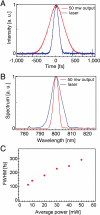Compact and flexible raster scanning multiphoton endoscope capable of imaging unstained tissue
- PMID: 22006303
- PMCID: PMC3203813
- DOI: 10.1073/pnas.1114746108
Compact and flexible raster scanning multiphoton endoscope capable of imaging unstained tissue
Abstract
We present a compact and flexible endoscope (3-mm outer diameter, 4-cm rigid length) that utilizes a miniaturized resonant/nonresonant fiber raster scanner and a multielement gradient-index lens assembly for two-photon excited intrinsic fluorescence and second-harmonic generation imaging of biological tissues. The miniaturized raster scanner is fabricated by mounting a commercial double-clad optical fiber (DCF) onto two piezo bimorphs that are aligned such that their bending axes are perpendicular to each other. Fast lateral scanning of the laser illumination at 4.1 frames/s (512 lines per frame) is achieved by simultaneously driving the DCF cantilever at its resonant frequency in one dimension and nonresonantly in the orthogonal axis. The implementation of a DCF into the scanner enables simultaneous delivery of the femtosecond pulsed 800-nm excitation source and epi-collection of the signal. Our device is able to achieve a field-of-view (FOV(xy)) of 110 μm by 110 μm with a highly uniform pixel dwell time. The lateral and axial resolutions for two-photon imaging are 0.8 and 10 μm, respectively. The endoscope's imaging capabilities were demonstrated by imaging ex vivo mouse tissue through the collection of intrinsic fluorescence and second-harmonic signal without the need for staining. The results presented here indicate that our device can be applied in the future to perform minimally invasive in vivo optical biopsies for medical diagnostics.
Conflict of interest statement
The authors declare no conflict of interest.
Figures






Similar articles
-
Multifocal multiphoton endoscope.Opt Lett. 2012 Apr 15;37(8):1349-51. doi: 10.1364/OL.37.001349. Opt Lett. 2012. PMID: 22513682
-
In vivo imaging of unstained tissues using a compact and flexible multiphoton microendoscope.J Biomed Opt. 2012 Apr;17(4):040505. doi: 10.1117/1.JBO.17.4.040505. J Biomed Opt. 2012. PMID: 22559671 Free PMC article.
-
Use of a lensed fiber for a large-field-of-view, high-resolution, fiber-scanning microendoscope.Opt Lett. 2012 Mar 1;37(5):881-3. doi: 10.1364/OL.37.000881. Opt Lett. 2012. PMID: 22378425
-
Multiphoton microscopy in life sciences.J Microsc. 2000 Nov;200(Pt 2):83-104. doi: 10.1046/j.1365-2818.2000.00738.x. J Microsc. 2000. PMID: 11106949 Review.
-
Scanning fiber endoscopy with highly flexible, 1 mm catheterscopes for wide-field, full-color imaging.J Biophotonics. 2010 Jun;3(5-6):385-407. doi: 10.1002/jbio.200900087. J Biophotonics. 2010. PMID: 20336702 Free PMC article. Review.
Cited by
-
Ultrahigh speed en face OCT capsule for endoscopic imaging.Biomed Opt Express. 2015 Mar 5;6(4):1146-63. doi: 10.1364/BOE.6.001146. eCollection 2015 Apr 1. Biomed Opt Express. 2015. PMID: 25909001 Free PMC article.
-
High-resolution, lensless endoscope based on digital scanning through a multimode optical fiber.Biomed Opt Express. 2013 Feb 1;4(2):260-70. doi: 10.1364/BOE.4.000260. Epub 2013 Jan 17. Biomed Opt Express. 2013. PMID: 23411747 Free PMC article.
-
Brain tissue responses to neural implants impact signal sensitivity and intervention strategies.ACS Chem Neurosci. 2015 Jan 21;6(1):48-67. doi: 10.1021/cn500256e. Epub 2015 Jan 12. ACS Chem Neurosci. 2015. PMID: 25546652 Free PMC article. Review.
-
Achromatic miniature lens system for coherent Raman scattering microscopy.Biomed Opt Express. 2013 Sep 19;4(10):2196-206. doi: 10.1364/BOE.4.002196. eCollection 2013. Biomed Opt Express. 2013. PMID: 24156075 Free PMC article.
-
In vivo imaging of neural activity.Nat Methods. 2017 Apr;14(4):349-359. doi: 10.1038/nmeth.4230. Epub 2017 Mar 31. Nat Methods. 2017. PMID: 28362436 Free PMC article. Review.
References
Publication types
MeSH terms
Grants and funding
LinkOut - more resources
Full Text Sources
Other Literature Sources
Medical

